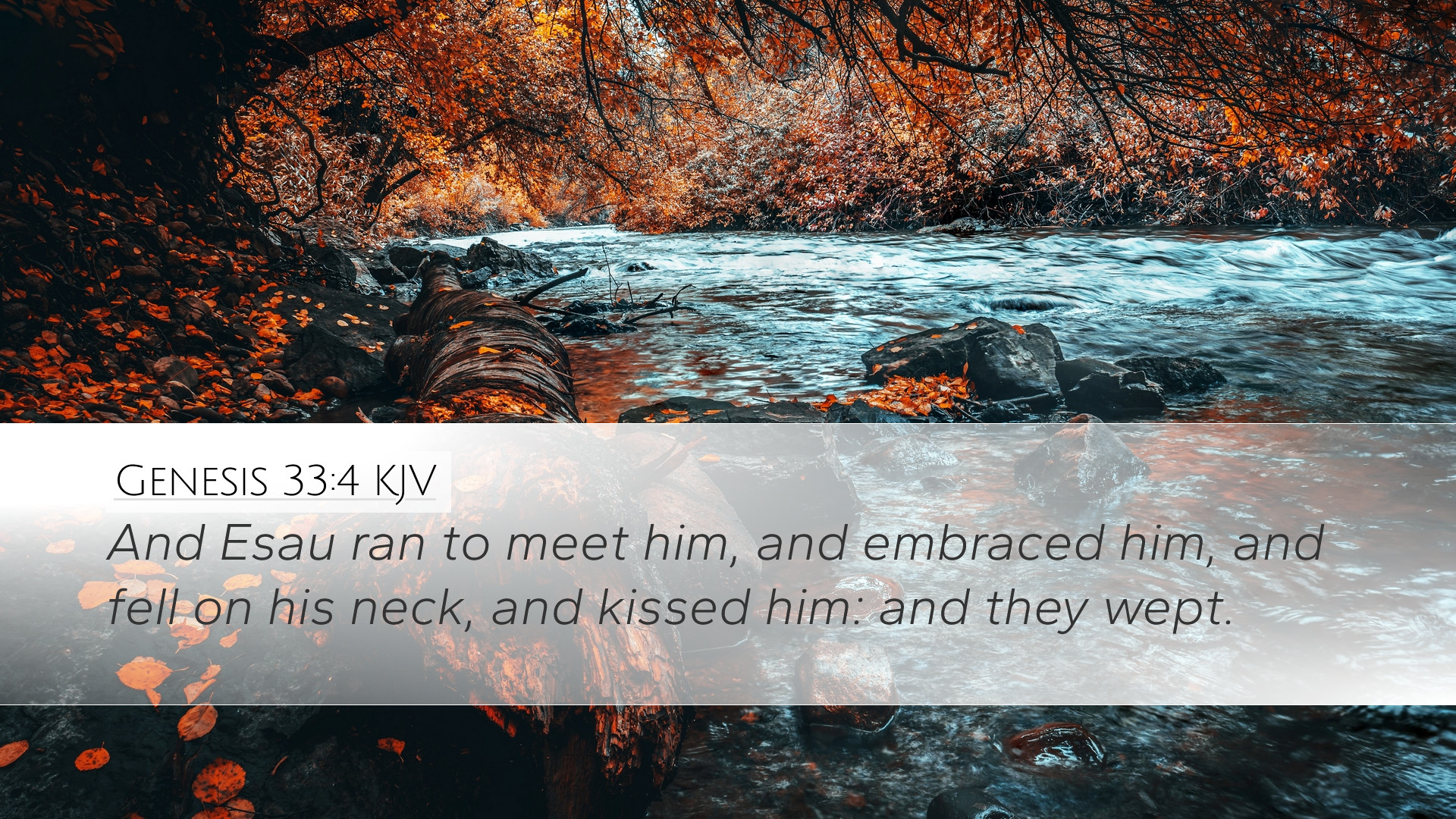Commentary on Genesis 33:4
Verse: "But Esau ran to meet him, and embraced him, and fell on his neck, and kissed him: and they wept."
Introduction
This verse presents a poignant moment in the narrative of Jacob and Esau, encapsulating themes of reconciliation, familial love, and the transformative power of forgiveness. After years of separation and tension, the reunion between the brothers is a climactic point in the Abrahamic covenant narrative. The event is rich in symbolic significance and offers a deep well of insights for pastors, students, theologians, and Bible scholars.
Contextual Background
Prior to this reconciliation, Jacob had taken his brother Esau's birthright and blessing, which led to Esau harboring a grudge against Jacob (Genesis 27). Fearing for his life, Jacob fled to Paddan-aram. After many years, during which Jacob prospered and formed his own family, he receives a command from God to return to his homeland.
In the lead-up to this verse, Jacob is anxious about his encounter with Esau and prepares with prayer, humility, and gifts to placate his brother (Genesis 32:1-21). The ultimate meeting, described in Genesis 33:4, reveals the depth of Esau’s love and Jacob's resolve.
Esau’s Actions: A Picture of Grace
Esau's response—running, embracing, and kissing Jacob—speaks volumes about his character and the healing of their relationship. This is contrasted sharply with the animosity that characterized their earlier relationship.
- Running to Meet Jacob: Esau, maintaining a posture of grace, is willing to bridge the gap. This act can be seen as a Christological shadow of God’s initiative in reconciling sinful humanity.
- Embracing: The embrace signifies acceptance and forgiveness. It transcends past grievances and speaks to a New Covenant reality where forgiveness restores relationships.
- Kissing: This deep affection emphasizes familial bonds and the enduring nature of brotherly love. It serves to remind readers of the importance of reconciliation in light of faith.
Theological Insights
Several theological themes can be extracted from this encounter:
- Reconciliation: The reconciliation between Jacob and Esau foreshadows the greater reconciliation available in Christ. Just as they were able to mend their strained relationship, believers are called to pursue peace with one another.
- Grace and Forgiveness: Esau’s willingness to forgive is a reflection of divine grace. In contrast to Jacob’s crafty ways, Esau’s character is marked by forgiveness, emphasizing the theme that grace can alter the course of human relationships.
- The Role of Humility: Jacob approaches the encounter with humility, demonstrated through his gifts and demeanor. This serves as a powerful reminder of the necessity of humility in resolving conflicts.
Jacob’s Transformation
This encounter marks a significant transformation in Jacob's life. Previously depicted as deceptive and self-serving, Jacob’s humility suggests a spiritual awakening.
- From Deception to Humility: Jacob has moved from employing cunning strategies to seeking reconciliation in a humble manner. This reflects personal growth and aligns with the biblical theme of transformation through divine encounters.
- Acknowledgement of God’s Favor: Jacob understands that it is indeed God’s favor that has brought him back safely, as seen in his earlier prayer. This realization enables him to confront his past with renewed faith.
Historical and Cultural Perspectives
The cultural context of this passage also sheds light on the significance of familial relationships in ancient Near Eastern societies. Kinship was a cornerstone of societal structure, and the reunion emphasizes the importance of maintaining familial ties.
Moreover, the act of embracing was indicative of peace: a gesture that would typically neutralize longstanding animosities and pave the way for future relationships.
Practical Applications
For contemporary readers, particularly pastors and theologians, practical lessons arise from this narrative:
- Pursuing Peace: The proactive approach taken by Esau illustrates the importance of taking steps towards reconciliation. Followers of Christ are encouraged to be peacemakers actively.
- Embracing Forgiveness: Just as Esau forgave Jacob, individuals are urged to extend grace to those who have wronged them, reflecting the love of God.
- Humility in Relationships: The story teaches that humility can lead to restorative encounters and healing in fractured relationships.
Conclusion
Genesis 33:4 serves as a profound narrative of reconciliation that transcends its historical context. It offers vital lessons on grace, humility, and the transformative power of forgiveness. As Jacob and Esau’s relationship is restored, the faithful are reminded of God's mercy and the call to live out the principles of reconciliation in their own lives.


